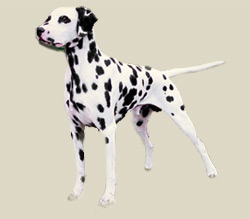
Country of Origin: Yugoslavia
Group: Scenthounds and Related Breeds
Section: Related breeds
Original Function: carriage dog
Todays Function: companion
Dimension Male: 50-60 cm
Dimension Female: 50-55 cm
Weight Male: 18-27 kg
Weight Female: 18-27 kg
Litter Size: 7-9 puppies
Life span: 12-14 years
Other Names: Fire Engine Dog
Colors: You may easily recognize the dalmatian because of the characteristic spots on its coat. these spots
Living: Contrary to popular belief, dalmatians can live in apartments, townhomes, and homes without large ya
Recognized: CKC, FCI, AKC, UKC, KCGB, CKC, ANKC, NKC, NZKC, APRI, ACR
Description
The familiar dapper black & white spotted dog of Disney fame, the Dalmatian is a symmetrical, muscular medium-sized dog with superior endurance. A picture of elegance, the Dalmatian has the lean, clean lines of the pointer, to which it may be related. It has a short, hard, dense coat of pure white with black or liver colored spots randomly splashed over it. The spots can be black, brown (liver), lemon, dark blue, tri colored, brindled, solid white (highly discouraged in show dogs), or sable. The feet are round with well-arched toes and the nails are either white or the same color as the spots. The nose can be either black, brown (liver), or blue or a dark gray that looks like black. The eyes are dark brown, amber, or blue, with an intelligent expression. The ears are soft, narrowing toward the point, carried with a slight upward curve. The more defined and well distributed the marking, the more valued the dog. Puppies are born completely white and the spots develop later.
Temperament
Bred to run for miles, the Dalmatian retains this tireless enthusiasm. It is a playful, eager companion that must get daily hard exercise in a safe area if it is expected to behave at home. It loves to run and may roam. It may be aggressive toward strange dogs, but it is generally good with other pets and is especially good with horses. It may be too energetic for young children. It tends to be reserved toward strangers. It can be stubborn.
Excercise
The Dalmatian needs a lot of regular exercise and attention. It needs more than a short walk on leash; it makes a good jogging companion. It can also have its needs met with vigorous games and runs. Although the Dal can live outside in temperate or warm climates, it needs shelter, soft bedding and, most of all, companionship. Thus, it is best allowed to live in the house and play in the yard. The coat needs only minimal care, but more frequent brushing will help remove dead hair.
Grooming
The Dalmatian sheds profusely twice a year. It is a hardy, easy to keep breed, though frequent brushing is needed to cope with constant shedding. They do not have a doggy odor and are said to be clean and even avoid puddles. Bathe only when necessary.
Health
Major concerns: deafness, urolithiasis
Minor concerns: allergies, epilepsy
Occasionally seen: CHD, vWD
Suggested tests: hearing
Note: A unique defect of the Dalmatian is its inability

